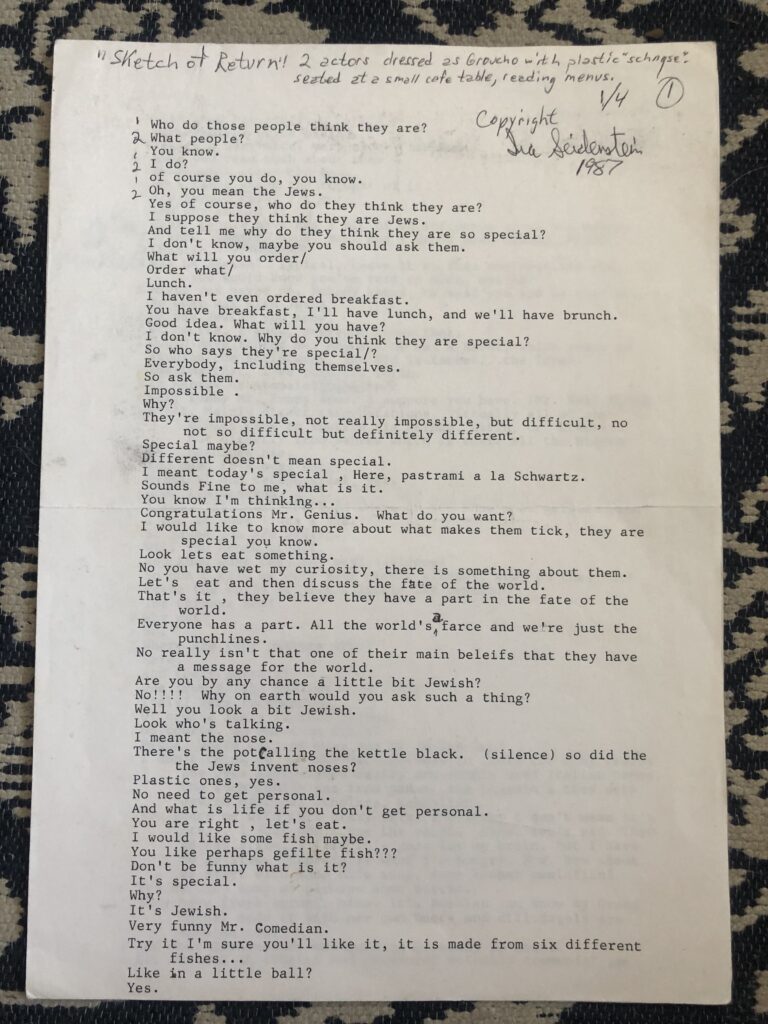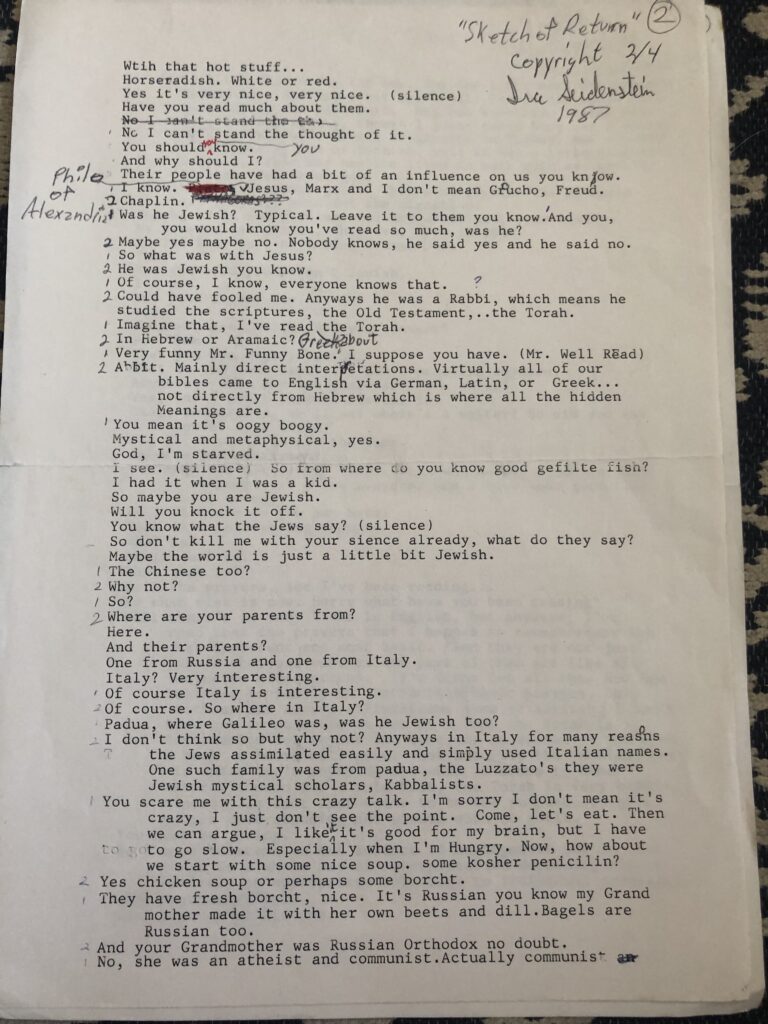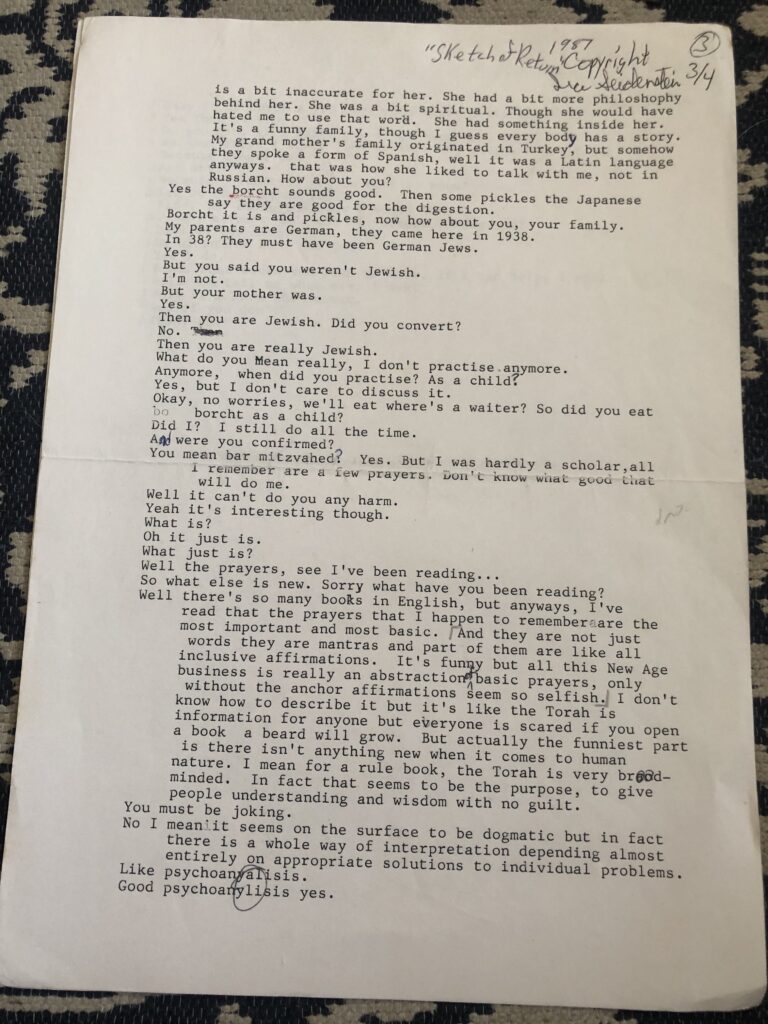
The photo is NOT from Sketch of Return. The comical glasses, nose, and moustache are.
The photo is from a workshop showing. As the teacher, I was asked (insisted upon) to participate in the showing. I asked the actors to take whatever costume bits they wanted out of our bits bags. I would take from the remains. What I am wearing IS exactly what was remaining!!! From that I became some character of some sort that you see.
The Introduction and Background information is about a 10 minutes read. Then comes the script of Sketch of Return that is about a 5 minutes read.
Sketch of Return is comical. I can’t say it is funny. It is definitely comical. The characters are two men. Each character is wearing a Groucho schnoze with black glasses and a moustache. As per the photo.
The characters can be played by women, or a woman and man, or as intended for two men. Or any currently fluid gender variation of one’s choosing.
The full script duologue of Sketch of Return is below. It was written in 1987. Misplaced for decades it never had a private or public reading or performance.
The concept of return is one of dozens or hundreds of foundation principles in the Jewish Culture. In Sketch of Return, each character is in denial about being Jewish. Each accuses the other of being Jewish. Let’s call the two characters Won and Too. In the script it is 1 and 2. The script is didactic and simply alternates one line each as in: 1 then 2 then 1 then 2 etc. Or Won then Too then Won then Too etc.
Return and Denial are two themes which occur for many people from many different cultures.
There was briefly in the UK a Black comedienne of Nigerian heritage – Jocelyn Jee Eslen. Her TV sketch comedy on for two seasons was titled Little Miss Jocelyn. She was an exceptional actress and clown. She wrote the show. Jocelyn had about a dozen characters. One was a mature aged office worker named Fiona. Fiona was in total denial that she was a ‘person of color’.
I wrote Sketch of Return in 1987, when I was first starting to read a few books about Jewish history, Judaism, Kabbalah, and numerous short stories written by Isaac Bashevis Singer the Nobel Laurette for Literature in 1978. Some books discussed the idea of “return”. In Hebrew the word is ‘teshuvah’. It is an amazing and complex topic. If you want a quick but authentic essay you can put ‘teshuvah’ into the Search on chabad dot org website.
There is nothing Jewish that is simple. Nothing. The Talmud itself is an 800 years discussion. A single discourse consisting of arguments about arguments with the idea that there is no final conclusion there is only a continuing discussion. One could estimate there may be ‘100,000’ books discussing (arguing) about the Talmud. The Talmud is a way of engaging with the Torah and the Tanach (the Hebrew acronym for: ta-na-ch i.e. Torah Navi Ketuvim which in English are Torah-Prophets-Writings). Tanach is the core 24 books of the Jewish canon. Those 24 books which the Talmud discusses at length.
The script of Sketch of Return found below, can be read on its own like a short story with a reading time of 5 minutes. If it were acted out it may take 10 minutes or so?
Many people from many Cultures choose to make a return. Often it is a return to ‘find oneself’. Often that becomes a lifelong passion of deepening one’s experience of Being. It is a private matter that requires study. It can be filled with challenges and fraught with obstacles. The engagement is enriching. In the Jewish Culture teshuvah is encouraged on a daily basis for a lifetime.
For myself, I love to meander as much as I love to focus. My desire to do teshuvah was going on my whole life. It is only that at one period I began to attempt to physicalize teshuvah.
My first misunderstanding was that I thought reading and thinking about teshuvah was teshuvah. Instead it is that teshuvah requires action. A variety of actions. Some of those or formalized as “Mitzvot” or a practice of making ‘connections’ to one’s Source. Mitzvah singular ending is -‘ah’ whereas mitzvot plural has an ending -‘ot’). Mitzvah requires Thought-Speech-Action. The experience and challenge of Thought i.e. concentration (kavanah) IS part of the mitzvah. It is the engagement that helps to make the mitzvah or ‘connection’.
My own teshuvah is on going. It is gradual, meaningful, enjoyable, and challenging. In theory I am researching a book about that experience. The future book is intended to be: Remnants – Encounters With My Jewish Culture. I’ve written a long blog about the project.
There were two key kick starters that inspired the project. First was that in three cities in a row in Europe for my workshops, in each city, a single actor in each asked me: “Ira why are there so many Jewish clowns”? Each time I answered “I don’t know”. But ‘three’s a charm’ and I thought it is time for me to know or find out why and something else.
Spoiler Alert: I do not accept the common adage reasoning for ‘so many’ Jewish comedians is ‘because Jewish people have suffered so much’. No, lots of groups of people have suffered. So I don’t accept that adage as applied to Jewish clowns either. I felt rather that the main part of the reason for ‘so many’ as in an unusual high percentage per capita – has everything to do with the Culture itself which is formally based on: Torah, Tanach, Talmud, Zohar, etc. That is an educated literary conscious basis for our Indigenous Jewish Culture of Practices.
When I began to research for the answer as to ‘why so many’ – it became clear that those sacred texts also contain humor both in situational stories and jokes and wordplay inside the actual texts. Additionally, it is quite obvious even in the most ritualized moments that humor is ever at the ready to be applied at any moment before, after, and even sometimes during the most sacred moments.
After he question about ‘why so many clowns’, the second kick starter for teshuvah, was that after teaching and mentoring several times in Ireland (Northern Ireland mainly as well as The Republic of Ireland). I thought well if I’m going to keep coming here, I know a fair bit about the work of Irish writer Samuel Beckett, and I even have a “Waiting For Godot Exercise” in my method’s daily training.
But I did not know much of the works of the ‘other’ legendary Irish writer – James Joyce. One of Joyce’s greatest works famously has a Jewish main character.
That great novel is Ulysses and the character I’m referring to is Leopold Bloom for whom an annual international literary festival is named as Bloomsday. I knew a bit about the novel and the character. Leopold Bloom was often considered as worthy of its own one-man show and many Jewish actors considered tackling it in their own way. The thought occurred to me but Leopold Bloom although considered one of the greatest character creations in English Literature he was not an ideal specimen of Jewish values – not at all. Nonetheless I started with reading some of Joyce’s short stories and short novels to get a foundation for Ulysses.
I planned a trip for 4 days to the main city where Joyce really began to write in earnest. That was Trieste, Italy. Just prior Joyce’s long residence in Trieste, he was briefly teaching English in nearby Pula, Croatia. The isolated town didn’t suit him. He took work in Trieste. His writing launched itself. He found a fellow writer who was a Tristian. They became friends and colleagues. Italo Svevo was the friend but that is only his famous pseudonym. He was Aron Hector Schmitz and was Jewish. Svevo and Joyce were each a modern and experimental writer.
It is said by Joyce’s daughter that the two men went for a 2 hours walk and talk each day. With Joyce soon becoming mildly obsessed with asking Italo/Aron about Jewish identity and his relation to it and about Judaism in an ongoing inquisition:) for details etc.
Joyce lived in Trieste from 1905 to 1920. According to Ira Nagel author of the book: Joyce and the Jews. Nagel notes that Joyce clearly had closest of friends who were Jewish in each of his main writing cities of: Dublin; Trieste; Rome; Zurich; Paris. In most of those cases each helped Joyce not only simply as friends, but also emotionally and professionally as several mentored him in important ways. In Trieste notes Nagel; “Among his Jewish friends Joyce numbered businessmen, writers, and Rabbis”. (pg. 202).
From Trieste Joyce and family moved to Paris where he met Paul Leon who mentored and proof read Joyce’s other great work in process. That enormous work is Finnegan’s Wake. In this period and inspirational to Finnegan’s Wake was the study and influence of the Talmud as taught and explained by Leon. Joyce and Leon met nearly every afternoon to work on and towards the final novel. Nagel tells “Leon was a part of every significant literary event involving Joyce from 1929-1940” (pg. 229).
Most remarkably, in a final effort to rescue Joyce’s library and papers Leon returned from Vichy back to Nazi Occupied Paris and was able to get everything to the Irish Embassy so that the collection would be preserved in the National Library of Ireland. Later Leon was arrested by the Gestapo and transported to imprisonment at Drancy, then Campiegne then to Silesia where he was murdered.
I went to Trieste to just see what it was like where Joyce wrote about Leopold Bloom and much more. I booked an Bed & Breakfast near the tiny Svevo/Joyce museum. I arrived late Friday night. Saturday morning after breakfast I left the building to walk towards the museum. I got to the corner and something happened.
It was a red light. I stood at the corner. Directly across the street was an Orthodox Jewish man who I guessed was also a Rabbi. He waited and held the hand of his little daughter and with the other hand his little son. The children were around 6 years old.
The light changed. We walked and passed each other.
I got the corner and stopped solidly. I turned around. I looked the Rabbi walking with his children. I knew of course that they were going to a Synagogue as it was Shabbat.
I understood. Why should I pursue so earnestly the assimilated Jews of Leopold Bloom and Italo Svevo?
No Ira. This is teshvah. Return. Teshuvah is often interpreted as “turn around”.
I had literally stopped in my tracks and did teshuvah. I turned around. I followed the Rabbi. Symbolically a Rabbi is like a living Torah. After several left and right turns, several blocks later I caught up to the Rabbi at a red light on a street corner. I introduced myself, quickly before the light would change. I asked if I could go to shule to synagogue with him. That was about 2017.
But that teshuvah was already in gear with SKETCH OF RETURN (by Ira Seidenstein – 1987)




Ira Seidenstein – approximately 90 blog essays so far. Two books, self-published Print-On-Demand. Clown Secret. Quantum Theatre: Slapstick to Shakespeare. www.iraseid.com – iraseid@gmail.com